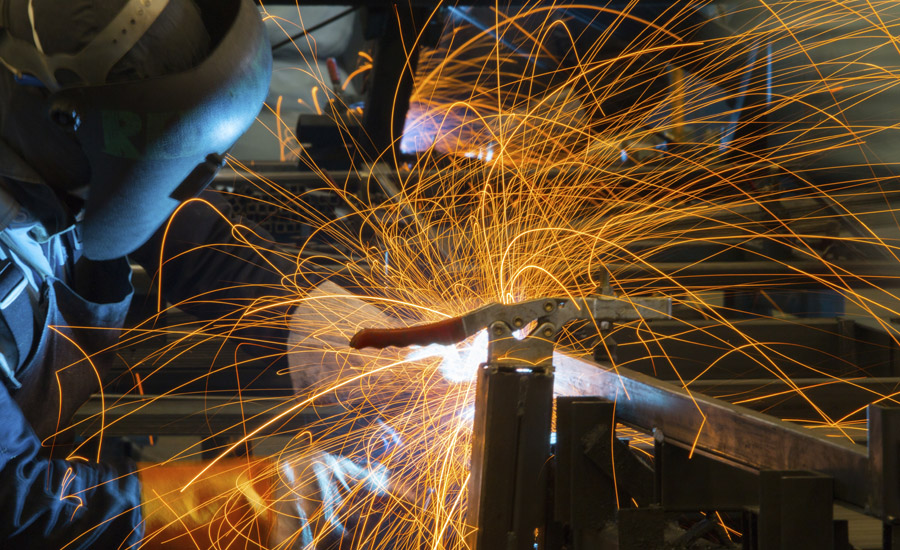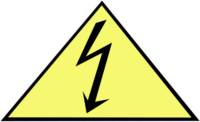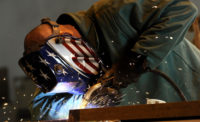by John Petkovsek, Director, Environment, Health and Safety, The Lincoln Electric Company
To help keep welders safe, the American Conference of Governmental Industrial Hygienists (ACGIH) and OSHA offer safety guidelines to help workers avoid welding hazards. Awareness of the most common welding hazards and knowing how to avoid them creates a safe, productive work environment for all.
Electric shock
Electric shock can lead to severe injury or death, either from the shock itself or from a fall caused by the reaction to a shock.
Electric shock occurs when welders touch two metal objects that have a voltage between them, inserting themselves into the electrical circuit. If a worker holds a bare wire in one hand and a second bare wire with another, electric current will pass through that wire and through the welding operator, causing an electric shock.
The most common type of electric shock is secondary voltage shock from an arc welding circuit, which ranges from 20 to 100 volts. Even a shock of 50 volts or less can be enough to injure or kill an operator, depending on the conditions. Due to its constant change in polarity, alternating current (AC) voltage is more likely to stop the heart than direct current (DC) welders. It is also more likely to make the person holding the wire unable to let go.
To avoid secondary voltage shock, welding operators should wear dry gloves in good condition, never touch the electrode or metal parts of the electrode holder with skin or wet clothing and be sure to insulate themselves from the work and ground, keeping dry insulation between their body and the metal being welded or ground (such as a metal floor or wet surface).
Welding operators also should inspect the electrode holder for damage before beginning to weld and keep the welding cable and electrode holder insulation in good condition, because the plastic or fiber insulation on the electrode holder prevents contact with the electrically “hot” metal parts inside. Be sure to repair or replace damaged insulation before use. Stick electrodes are always electrically hot, even when welding is not being done and the voltage is the highest.
Primary voltage shock can occur when a welder touches electrically “hot” parts inside the welder case or the electric distribution system to which the welder is connected. This action can lead to a shock of 230 or 460 volts.
When not in use, but still turned on, most welding equipment have a voltage that ranges from 20 to 100 volts at the welding circuit and voltages inside the welding equipment may range from 120 volts to more than 575 volts, all of which pose a risk for electric shock. Only qualified repair technicians should attempt to service or repair welding equipment.
Fumes and gases
Welding fume contains potentially harmful complex metal oxide compounds from consumables, base metal and the base-metal coatings. It’s important to keep your head out of the fumes and use enough ventilation and/or exhaust to control your exposure to substances in the fume, depending on the type of rod and base metal being used.
Welding areas require adequate ventilation and local exhaust to keep fumes and gases from the breathing zone and the general area. In most situations, employers will provide a ventilation system- such as a fan, and an exhaust system or fixed or removable exhaust hoods- to remove fumes and gases from the work area.
Be aware that there are ACGIH threshold limit values (TLV) and OSHA permissible exposure limits (PEL) for the substances in welding fume. Welding operators should wear an approved respirator unless exposure assessments are below applicable exposure limits.
Fire and explosions
The welding arc creates extreme temperatures, and may pose a significant fire and explosions hazard if safe practices are not followed. The welding arc may reach temperatures of 10,000 degrees Fahrenheit, but the real danger is not from the arc itself, but rather the heat, sparks and spatter created by the arc.
To prevent fires, before beginning to weld, inspect the work area for any flammable materials and remove them from the area. Flammable materials are comprised of three categories: liquid, such as gasoline, oil and paint; solid, such as wood, cardboard and paper; gas, including acetylene, propane and hydrogen.
Injuries from insufficient PPE
Personal protective equipment (PPE) helps keep welding operators free from injury, such as burns – the most common welding injury – and exposure to arc rays. The right PPE allows for freedom of movement while still providing adequate protection from welding hazards.
Leather and flame-resistant treated cotton clothing is recommended in welding environments. This is because synthetic material such as polyester or rayon will melt when exposed to extreme heat. Welding leathers are especially recommended when welding out of position, such as applications that require vertical or overhead welding.
Avoid rolling up sleeves or pant cuffs, as sparks or hot metal will deposit in the folds and may burn through the material. Keep pants over the top of work boots – don’t tuck them in. Even when wearing a helmet, always wear safety glasses with side shields or goggles to prevent sparks or other debris from hitting the eyes. Leather boots with 6-to-8-inch ankle coverage are the best foot protection; metatarsal guards over the shoe laces can protect feet from falling objects and sparks.
Heavy, flame-resistant gloves should always be worn to protect from burns, cuts and scratches. As long as they are dry, they also should provide some protection from electric shock. Leather is a good choice for gloves.
Helmets with side shields are essential for protecting eyes and skin from exposure to arc rays. Make sure to choose the right shade lens for your process – use the helmet’s instructions to help select the right shade level. Begin with a darker filter lens and gradually change to a lighter shade until you have good visibility at the puddle and weld joint but it is comfortable and does not irritate your eyes. Wear a helmet at all times during welding.
To protect ears from noise, wear hearing protection if working in an area with high noise levels.
Source: Lincoln Electric www.lincolnelectric.com



